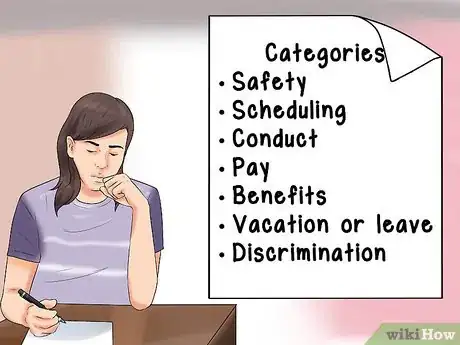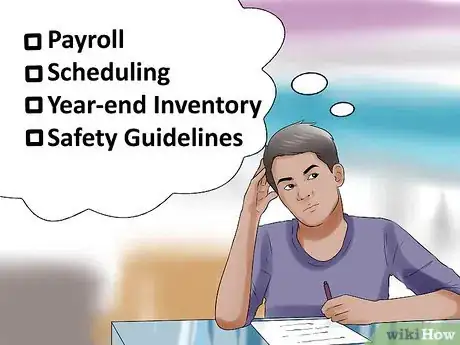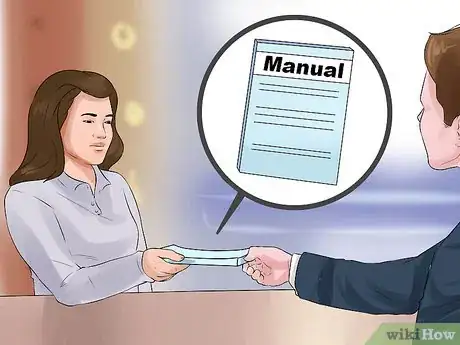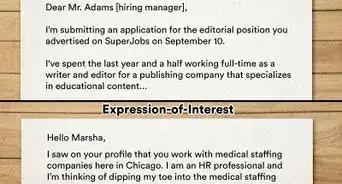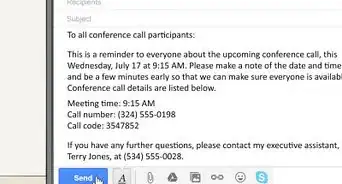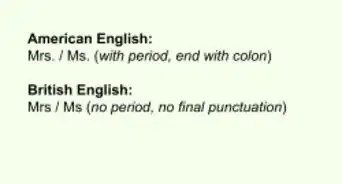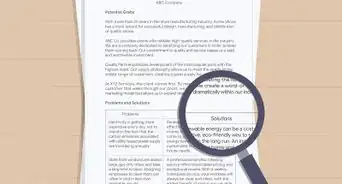This article was co-authored by wikiHow Staff. Our trained team of editors and researchers validate articles for accuracy and comprehensiveness. wikiHow's Content Management Team carefully monitors the work from our editorial staff to ensure that each article is backed by trusted research and meets our high quality standards.
There are 8 references cited in this article, which can be found at the bottom of the page.
wikiHow marks an article as reader-approved once it receives enough positive feedback. In this case, 86% of readers who voted found the article helpful, earning it our reader-approved status.
This article has been viewed 243,125 times.
Learn more...
Written policies and procedures integrate the guidelines, rules, focus, and principles of an organization. The policy and procedures are generally incorporated into a manual made available to the staff. How you write policies and procedures for your business depends on the goals of the company.
Steps
Outlining the Goals of Your Business
-
1Make a list of goals. As a manager or business owner, you know best the goals for your company. Consider things like sales goals, goals for employees and management, and where you would like to see your business a few years down the road.
- Try to make your goals not only as specific as possible, but also attainable and worthy of working towards. For example, set financial goals that are within probability for your business, and set goals for employee performance that are achievable through following the policies and procedures you will set.[1]
- Once you’ve set the goals, make sure you are ready to commit to them as a business owner or manager. Setting goals is an important first step in crafting policies and procedures. Of course, following through is equally as important.
-
2Write down a list of tasks and procedures. Think about the day-to-day happenings and duties in your business. Write down each task that would need to be done each day to keep things running smoothly.
- Consider the following: what tasks will need formal outlining or directions? Which procedures will need to be done consistently the same way? Rather than focusing on menial tasks that won’t need much instruction, focus on the bigger picture items.[2]
Advertisement -
3Create a list of possible problems and their potential solutions. Policies exist in business to keep things running smoothly and to hold employees and managers to certain standards of performance. Think about the problems that could arise if there are no policies in place. This will help you come up with the policies themselves.[3]
- While thinking of potential issues, come up with brief ideas for how you might solve or correct them. Think of issues surrounding the day-to-day activities of your business, such a financials, interactions between employees and customers, and employee behavior and conduct.
Writing the Policies of Your Business
-
1Make a list of policy categories. Once you have considered different possible issues you want your policies to address, come up with categories for them. For example, you might use categories like safety, scheduling, conduct, pay, benefits, vacation or leave, and discrimination.[4]
- When it comes time to compile a manual, having policies already separated into categories will help you organize the manual and keep these sections together. It will also help you decide what is most important, and be able to address those things in more detail.
-
2Use an outline format to detail different policies under each category. Outlines allow you to explore deeper aspects of each policy or category, adding in stipulations and specifics as you go. Use numbers to order each section or category.[5]
- Start with a brief, shorthand outline. Later, once you’ve gone through once and written down all your initial ideas, you can go back through and lengthen the sections accordingly.
-
3Come up with appropriate consequences for breaking policy. Policies allow your business to function properly while holding employees and management to certain standards. They also will serve as a written document that outlines how to handle things when the policy is disrupted or broken. This is especially important when and if any action needs to be taken following the disruption.[6]
- Policies, when written in a formal document, can outline any legal rights and obligations of your employees and of the company. In the US, this includes information regarding the Americans with Disabilities Act, taxes, and laws that prohibit discrimination and harassment in the workplace. Make sure you include information on applicable federal and state laws when crafting your policies.
-
4Have clear policies regarding termination. Should you ever have to fire an employee for breaking policies, the written policies themselves will serve as evidence if that employee argues they were terminated unfairly. Make sure you have a section in your policies regarding what will constitute termination.[7]
- You should also have policies regarding hiring. For example, you might require background checks prior to employment, or a probationary period after hiring before employment becomes permanent. Make sure you outline and set these terms clearly.
-
5Use clear, active language. Make sure you write all policies clearly and in such a way that could not be misunderstood or misconstrued. If there are other interpretations of the policy, consider rewriting it.
- For example, instead of saying something like “Some circumstances may allow for extra sick days,” you might say something like “Extra sick days can only be approved at the explicit consent of the manager on duty.”
Writing Procedures
-
1Determine which tasks need detailed, outlined procedures. Not every average task or incident will need detailed instructions for handling or carrying out. Prioritize the tasks or procedures that need to be done with consistency, such as payroll or scheduling.[8]
- When deciding which procedures to outline in detail, consider the following: is the procedure lengthy or complex? Would the consequences of doing it incorrectly be severe? Have there been recent important changes implemented to it? Does the procedure require any extensive or important paperwork? Are employees frequently confused by it?
-
2Collect necessary information for each procedure. Before you can detail the procedure, you will need to know every step and aspect of it. Consider employee questions that have been raised in the past, and issues you may have already encountered.[9]
- Even once you have all the information, you will want to stick to the basics when writing the procedure itself. Think about what the reader or employee will need to be able to understand and carry out the procedure.
-
3Use all information to write clear procedures. Use an active voice when writing the procedures themselves. Try to avoid being too wordy. Make sure you aren’t using language that isn’t easily understood, including any jargon that an employee might not understand yet.[10]
- For example, rather than saying “The pay stubs must then be filed with accounting,” you might say something like “File the pay stubs with accounting.”
Understanding Legalities
-
1Include a section on anti-discrimination policies. All business owners in the US must adhere to certain anti-discriminatory policies set forth by the government. Make sure you include information on these policies along with how you expect employees to adhere to them as well.[11]
- Equal opportunity employment information should be included within the policies, as well as the Americans with Disabilities Act, and policies against harassment. You can find information in this through the US Small Business Administration.[12]
-
2Make sure your policies are legal. Through the US Small Business Administration, and the Bureau of Economic and Business Affairs, make sure any and all policies you have set forth are legal and fair. The US Department of State offers great online resources for all business owners to find the information they need.[13]
- You might consider having a business attorney look over your policies before mandating them to your employees. As a business owner, having a lawyer you can consult with on a regular basis is a good tool.
-
3Have employees sign any new drafts of your policies and procedures. New hires should be required to agree to and sign the policies and procedures document, as well as be given a copy of them for reference. In addition, any changes made should be re-signed by all employees. This will assure they are held to these policies should any legal action be taken by either party in the future.[14]
- Minors cannot legally agree to contracts. Make sure if you are hiring anyone under the age of 18, they have written permission from a guardian to enter into the contract, as their parent or guardian could legally cancel the contract.
Compiling a Manual
-
1Organize information into a logical order. Start with the more encompassing issues, then narrow down into the smaller ones. For example, rather than starting with the category of compensation, you might start the manual with the category of hiring processes or eligibility.[15]
- Consider opening the manual with a description of your company’s goals, as you originally outlined them. Write a cohesive, clear paragraph or two that briefly overviews the manual, what your employees can expect from the company, and what the company expects of them.
- Use the outlining style to create subcategories within the manual. Use a table of contents once you’re finished to allow for quick reference.
-
2Use images, charts, or diagrams. Some people are more visual than others, so having diagrams, charts, or images in your manual can help different types of employees grasp the concepts in it. These types of images can simplify different procedures and policies alike.[16]
- For example, you might make a chart or table that lists different position titles and their duties as a quick point of reference. You could also use a table that includes questions and answers for employees to use and reference as needed.
-
3Make the manual accessible to all employees. Ideally, new employees will receive a copy of the manual upon hire, and existing employees will get new copies when any revisions are made. You might consider having employees sign a contract stating that they understand the things outlined in the manual, and agree to them.[17]
- Keep copies of the manual on hand at your place of business, as well as digital copies for you to access and revise as needed. The goal is to make sure these policies and procedures are both understood and carried out properly, and should issues arise, the manual can be there to guide the course of action.
Community Q&A
-
QuestionHow do I write a policy for truck drivers?
 Community AnswerYou always want to look into state and federal guides to make sure that you are adhering to those, and reference them somewhere within the policy so that the drivers can look into the policies/guidelines further. You need to do a step-by-step process to make sure you are covering all areas when writing a policy and procedure. You can Google plenty of websites that already have policies and procedures and mirror their template. Also, look at your current employee handbook for some things you can take from there and implement.
Community AnswerYou always want to look into state and federal guides to make sure that you are adhering to those, and reference them somewhere within the policy so that the drivers can look into the policies/guidelines further. You need to do a step-by-step process to make sure you are covering all areas when writing a policy and procedure. You can Google plenty of websites that already have policies and procedures and mirror their template. Also, look at your current employee handbook for some things you can take from there and implement. -
QuestionHow do I write policy and procedure for a gas station business?
 Community AnswerFollow the steps here, but think specifically about your gas station business.
Community AnswerFollow the steps here, but think specifically about your gas station business. -
QuestionWhat would be a short and simple policy I could use for a small waste management business?
 Community Answer1. Have an awareness of the broad range of environmental issues that might impact your organisation. 2. Have a broad understanding of the key aspects of waste management, especially the waste management options of reduction, reuse, recycling, and disposal. 3. Appreciate the financial and legislative importance of managing wastes in your business. 4. Identify potential areas within your business where you maybe able to reduce your waste production.
Community Answer1. Have an awareness of the broad range of environmental issues that might impact your organisation. 2. Have a broad understanding of the key aspects of waste management, especially the waste management options of reduction, reuse, recycling, and disposal. 3. Appreciate the financial and legislative importance of managing wastes in your business. 4. Identify potential areas within your business where you maybe able to reduce your waste production.
Warnings
- Ask before including a direct contact number for a department or person.⧼thumbs_response⧽
References
- ↑ http://www.notredameonline.com/resources/business-administration/six-tips-for-setting-business-goals/#.V12dbBMrLnA
- ↑ https://www.mindtools.com/pages/article/newTMC_78.htm
- ↑ http://www.asha.org/slp/healthcare/policy_procedures/
- ↑ https://www.sba.gov/starting-business/hire-retain-employees/employee-handbooks
- ↑ https://www.nfib.com/documents/pdf/faststart/model-employee-handbook.pdf
- ↑ https://www.sba.gov/starting-business/hire-retain-employees/employee-handbooks
- ↑ https://www.sba.gov/starting-business/hire-retain-employees/employee-handbooks
- ↑ https://www.mindtools.com/pages/article/newTMC_78.htm
- ↑ https://www.mindtools.com/pages/article/newTMC_78.htm
- ↑ https://www.mindtools.com/pages/article/newTMC_78.htm
- ↑ https://www.sba.gov/starting-business/hire-retain-employees/employee-handbooks
- ↑ http://webapps.dol.gov/elaws/elg/
- ↑ http://www.state.gov/e/eb/cba/tools/index.htm
- ↑ http://smallbusiness.findlaw.com/business-contracts-forms/will-your-contract-be-enforced-under-the-law.html
- ↑ https://www.nfib.com/documents/pdf/faststart/model-employee-handbook.pdf
- ↑ https://www.mindtools.com/pages/article/newTMC_78.htm
- ↑ https://www.nfib.com/documents/pdf/faststart/model-employee-handbook.pdf
About This Article
To write policies and procedures for your business, start by making a list of all the policies and procedures that you think deserve formal outlining and direction. Then, divide all of the policies into categories, like safety, scheduling, and benefits, and write them out using an outline format. You should also include appropriate consequences for breaking each policy. To write your procedures, start by breaking each procedure down into several steps. Then, outline the steps using active, easy-to-understand language. To learn how to compile a policy and procedural manual, scroll down!



